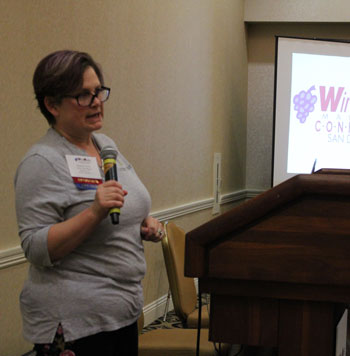Making good wine requires adhering to a few core principles — patience being one of them. Sometimes, though, winemakers who make kit wines feel that they don’t need to adhere to the same principles. Two winemaking supply shop owners who see this fault time and again discuss best practices for aging these wines.
 Gisela “G” Claassen PhD: Founder of Curds and Wine in San Diego, California
Gisela “G” Claassen PhD: Founder of Curds and Wine in San Diego, California
Time is the best ingredient home winemakers can add to their wines to take them from “pretty good” to great. Two mistakes I see winemakers make most often is not giving their wines proper aging time (both in bulk and in bottle) and not aging at the correct temperature.
One of the biggest benefits to bulk aging red wine kits is to let the wine degas. Even though a wine whip is often employed in the winemaking process for kit wines, red wines just won’t fully degas no matter how much you whip it — the gas just wants to come out naturally. I have found that bulk aging for a minimum of 3 months is the sweet spot for reds to degas before bottling. (White wines seem happier to give up their trapped CO2, sometimes quite explosively!)
All wines should be given at least one full month after bottling to get over “bottle shock,” where the flavor molecules get tossed around and exposed to air during the bottling process to the point that they can stick to each other, often in such a way that the flavors and aromas get masked from our receptors. A “shocked” bottle often tastes off or weird, and sometimes it tastes like nothing at all — like water! Bottle shock is not permanent, though, and even an “off” bottle will come around given sufficient time.
In general, most white, rosé, and dessert wines are very drinkable after that first month of aging. Some white wines with oak will taste better if you wait another 3-6 months for the oak to integrate. White and rosé wines will likely peak at 2 years or less; delicate flavor and aroma compounds, as well as color, will begin to degrade after that timeframe, especially if sulfite levels are low.
Red wines, on the other hand, need extra aging time. I find that most reds will need a minimum of 2 to 3 years to really open up, though they are often quite drinkable before that. Red wines have large compounds that need to rearrange chemically to please our palates, which takes time to occur and cannot be rushed. If you can hold on to a wine that long, you will experience a completely different wine from the early years, and you will regret drinking all but those last 2 or 3 bottles that are now perfect. For the less patient, there are a few value-priced, less complex red wine kits that are very drinkable within 6 months to a year. These include lighter-bodied, fruit-forward wines like Bergamais and Sangiovese; but even these will greatly improve if given more time. So be sure to create a diverse cellar with various wines.
If you give your wine the right amount of time, what you think might be an ugly duckling may end up a beautiful swan!
 Pamela Zorn: Owner of Wine & Whey, in Denver, Colorado
Pamela Zorn: Owner of Wine & Whey, in Denver, Colorado
People too often seem to be in a hurry to have wine to drink. As per a good friend of mine, we try to recommend the “build your cellar” method. Make a wine (white) that ages and tastes good, quickly. Also make a kit (red) that will age fairly quickly, 6–9 months, then make a high-end kit that requires at least 18-months aging. We will always add extra sulfite to the long-aging kit.
How much sulfite you ask? For any wine I am doing for myself, or if a customer asks about longer aging, especially of red wines, we add 1⁄4 to 1⁄2 tsp. extra sulfite per 5 gallons (19 L) of wine. Very few of our customers are interested in knowing the exact sulfite ppm, so as to not confuse or overwhelm them, we do not measure ppm.
At bottling, we let our customers taste the green wine, it usually convinces them to wait at least the minimum recommended time before drinking it. We recommend at bottling to fill some 375 mL bottles so that after the minimum recommended aging time, you taste a small bottle. If the taste is what you expect from that variety, go ahead and start drinking it. If not, continue aging. Taste, not sooner than every three months.
Make sure the airlock does not run dry and keep carboys topped up. The room that they are bulk aging in needs to be held at a steady temperature, whether it is a little too warm or a little too cool. Steady is more important. Check sulfite levels and I recommend racking to a clean carboy every few months to help with flavor and clarity.
Follow directions carefully. Take all the recommended hydrometer readings, keep detailed notes and, until you have several kits done and tasting good, don’t attempt to tweak the kit.
I also express the need for good water. My general rule is, if you like the water that comes from your tap, go ahead and use it. If you do not, then use bottled water. The water DOES make a difference to the overall outcome and flavor of your wine.

 Pamela Zorn: Owner of Wine & Whey, in Denver, Colorado
Pamela Zorn: Owner of Wine & Whey, in Denver, Colorado




